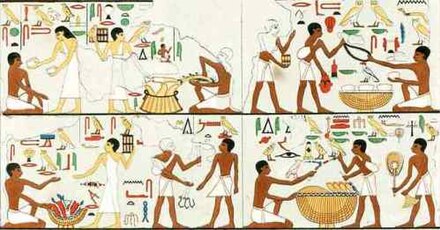Deben (unit)
| ||
| Deben[1] (w/"stone-block"–O39) (as determinative) (horiz. water-N) in hieroglyphs | ||
|---|---|---|
The deben was an ancient Egyptian weight unit.
Early Dynastic Period
The earliest evidence for deben is from the Early Dynastic Period. It was found at the site of Buto in Nile Delta. The weighing stone was uncovered in an archaeological context from Second Dynasty, in the so-called "labyrinth" building, it bears the inscription of the "friendly is the heart of Horus, director" (of the installation) "Hemsemenib". The inscribed value is of 3 deben, representing a unit of 29 grams (1.0 oz), likely the earliest copper deben.[2] Based on this evidence, it was argued recently that copper and gold deben were used since Early Dynastic Period in ancient Egypt.[3]
Old and Middle Kingdom

Set of balance beams and weighing stones from 10 to 100 units, likely deben, was painted on the wall of the tomb of Third Dynasty official Hesy-Ra at Saqqara.[4] Stone weights from the Old Kingdom have been found, weighing about 13.6 g (0.48 oz; 0.44 ozt), giving presumed value of the gold deben, e.g. the weighing stone of king Userkaf.[5] The same unit was used for the jasper weighing stone of the First Intermediate Period king Nebkaure Khety. From the Middle Kingdom date deben weight units used for particular metals, referred to as copper deben and gold deben, the former being about twice as heavy (27 g (0.95 oz; 0.87 ozt)) as the latter. Such weights from the Middle Kingdom were discovered at Lisht, using gold deben,[6] and copper deben.[7]
Second Intermediate Period
At the Second Intermediate Period site of Tell el-Dab'a were found sets of sphendonoid weighing stones confirming the use of shekel weighing system, both "Syrian" (9-9.5 g) and "Mesopotamian" (c. 8.1-8.5 g).[8] Here presumably stems the changed weighing system of the New Kingdom, with a completely different deben unit.
New Kingdom
From the New Kingdom one deben was equal to about 90 g (3.2 oz; 2.9 ozt) to 95 grams (3.4 oz; 3.1 ozt).[9] It was divided into ten kidet (alt. kit, kite or qedet) of c. 9.0 grams (0.32 oz; 0.29 ozt) to 9.5 grams (0.34 oz; 0.31 ozt),[10] or into what is referred to by Egyptologists as 'pieces', one twelfth of a deben weighing 7.6 g (0.27 oz; 0.24 ozt).[11] It was frequently used to denote value of goods, by comparing their worth to a weight of metal, generally silver or copper. The value of the metal artefacts was expressed by deben, and the weight equalled the value.[12]
Protocurrency
It has been speculated that pieces of metal weighing a deben were kept in boxes,[13] taken to markets,[14] and were used as a means of exchange.[15] Archaeologists have been unable to find any such standardized pieces of precious metal. On the other hand, it is documented that debens served to compare values. On the well-known Juridical stela from the reign of Nebiryraw I, debt of 60 gold deben (consisting in fact of gold, copper, grain, and clothes as listed on the stela) was worth the governorship of el-Kab. In the 19th Dynasty, a slave girl priced four deben and one kite of silver was paid for with various goods: 6 bronze vessels, 10 deben of copper, 15 linen garments, a shroud, a blanket, and a pot of honey.[16]
Legacy
Deben appeared in the computer game Pharaoh as its currency (in the form of gold).
See also
References
- ^ Allen, James P. (2000). Middle Egyptian: An Introduction to the Language and Culture of Hieroglyphs. Cambridge, UK: Cambridge University Press. p. 101. ISBN 0-521-77483-7.
- ^ Way, Thomas von der (1997). Tell el-Faraʻîn--Buto (in German). Joachim Boessneck, E. Christiana Köhler (1 ed.). Mainz: P. von Zabern. pp. 162–163, 171–172, Taf. 70: 9. ISBN 978-3-8053-1858-7. OCLC 39833382.
- ^ Odler, Martin (2023). Copper in ancient Egypt: before, during and after the pyramid age (c. 4000-1600 BC). Culture and history of the ancient Near East. Leiden Boston: Brill. ISBN 978-90-04-52769-0.
- ^ Edward., Quibell, James (1913). Excavations at Saqqara : (1911-12). Imprimérie de l'Institut Français d'Archéologie Orientale. pp. Pl. XVI. OCLC 1123959096.
{{cite book}}: CS1 maint: multiple names: authors list (link) - ^ "Weight: 5 deben | Old Kingdom". The Metropolitan Museum of Art. Retrieved 2023-05-10.
- ^ "Seventy deben weight | Middle Kingdom". The Metropolitan Museum of Art. Retrieved 2023-05-10.
- ^ "Weight: 23 1/4 debens, with cartouche of Senwosret | Middle Kingdom". The Metropolitan Museum of Art. Retrieved 2023-05-10.
- ^ Prell, Silvia; Rahmstorf, Lorenz (2021). "Implications for Trade – Weights from Tell el-Dabʿa as Indicators of Eastern Mediterranean Influence on Egypt". Excavating the Extra-Ordinary: Challenges & Merits of Working with Small Finds: Proceedings of the International Egyptological Workshop at Johannes Gutenberg-University Mainz, 8–9 April 2019: 133–153. doi:10.11588/PROPYLAEUM.676.C11288 – via Propylaeum.
- ^ Janssen, Jozef (1975-06-01), "Commodity Prices from the Ramessid Period: An Economic Study of the Village of Necropolis Workmen at Thebes", Commodity Prices from the Ramessid Period, Brill, ISBN 978-90-04-04211-7, retrieved 2023-07-22
- ^ Robert Steven Bianchi, Daily Life of the Nubians, Greenwood Press 2004, ISBN 0-313-32501-4 p.270
- ^ Iorwerth Eiddon Stephen Edwards, The Cambridge Ancient History, Cambridge University Press 1973, ISBN 0-521-08230-7, p.389
- ^ Janssen, Jozef (1975-06-01), "Commodity Prices from the Ramessid Period: An Economic Study of the Village of Necropolis Workmen at Thebes", Commodity Prices from the Ramessid Period, Brill, ISBN 978-90-04-04211-7, retrieved 2023-07-22
- ^ George A. Reisner, "The Household Furniture of Queen Hetep-heres I", BMFA 27, No. 164, December 1929, pp. 83-90
- ^ R. Lepsius, Denkmäler aus Aegypten und Aethiopien, Abth. II, Bl.96
- ^ T. G. H. James, Pharaoh's People: Scenes from Life in Imperial Egypt, Tauris Parke Paperbacks 2007, ISBN 1-84511-335-7, p.245
- ^ Iorwerth Eiddon Stephen Edwards, The Cambridge Ancient History, Vol 2, pt 1, Cambridge University Press 1973, ISBN 0-521-08230-7, p.390